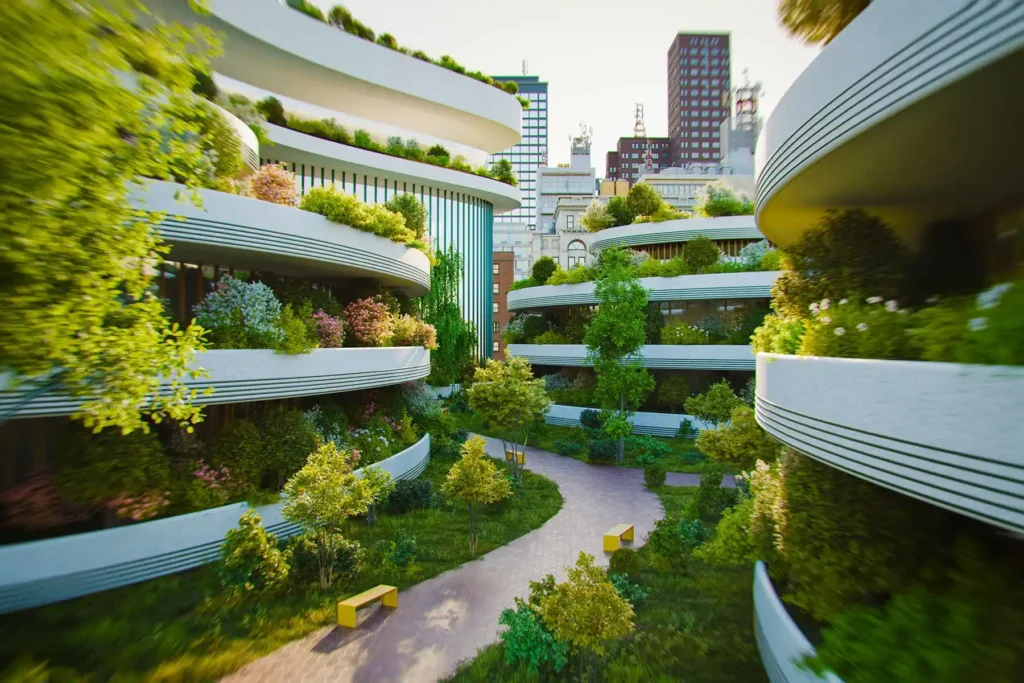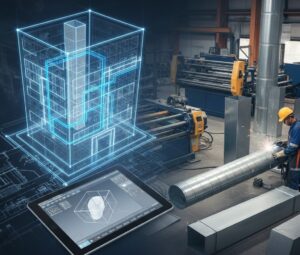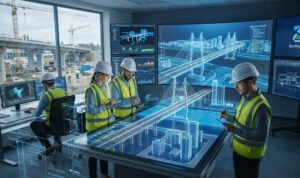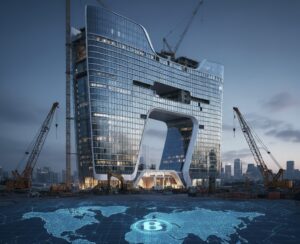The architecture and construction business in the modern age is in the center stage of establishing a sustainable future in a world where climate change and the shortage of resources are emerging as current world issues. The contemporary design by architects no longer emphasizes only the looks or functionality, but pays more attention to energy saving, environmental friendliness, and durability.
The world continues to witness a phenomenal change in residential architecture as well as commercial architecture. With green-certified corporate towers and net-zero energy houses, now sustainability forms part of the innovation. This blog offers an understanding of what sustainable and energy-saving solutions are doing to our approach to building and living, and how the methods vary when comparing commercial and residential construction.
Understanding Sustainable and Energy-Efficient Architecture
Sustainable architecture can be described as the approach of creating a building that has the least impact on the environment and in the process ensures the health and comfort of building occupants. It is a systemic philosophy that views the whole lifecycle of a construction – the design and choice of materials to be used, the construction, use, and dismantling.

A sustainable design prioritizes:
- Use of renewable and recyclable materials
- Energy and water conservation
- Reduced waste and emissions
- Efficient use of land and resources
Simply put, it’s about creating buildings that meet human needs without compromising the planet’s future.
What Makes a Building Energy-Efficient?
Energy efficiency is the backbone of sustainability. An energy-efficient building optimizes resource consumption through design elements such as:
- Proper insulation and glazing
- Passive heating and cooling systems
- Smart lighting and ventilation
- Renewable energy generation (e.g., solar panels)
When design by architects incorporates these elements early in the planning process, the result is a structure that requires less energy to operate, emits fewer greenhouse gases, and saves money over time.
Why It Matters
The construction industry contributes almost 40% percent of the total world-energy-related CO 2 emission. Going green and energy efficient in buildings is not a fashion, but it is a must. Sustainable architecture results in more than environmental benefits, including:
- Lower operational costs
- Enhanced indoor air quality
- Improved occupant well-being
- Greater long-term property value
Key Principles of Sustainable Architectural Design
Sustainability in both residential and commercial architecture rests on a few universal principles:
- Passive Design Strategies
Considerable orientation, natural ventilation, and maximization of daylight minimize the use of artificial lighting and the HVAC system. As an illustration, energy use can be reduced by up to 30 per cent through positioning windows in strategic places. - Use of Renewable and Local Materials
Materials like bamboo, reclaimed wood, and recycled steel reduce embodied carbon and promote regional craftsmanship. - Water Conservation
Incorporating rainwater harvesting, greywater recycling, and low-flow fixtures helps conserve one of our most precious resources. - Green Roofs and Living Walls
These features provide insulation, manage stormwater runoff, and enhance biodiversity, especially beneficial in dense urban environments. - Integration of Smart Technology
The IoT systems control and test the performance of buildings in real-time and improve their lighting, temperature, and energy consumption to ensure maximum efficiency.
These principles are applicable in all types of projects, but the application of these principles depends on the scale of the project, the purpose of the project, and the needs of the users- a difference that is particularly notable when commercial vs residential construction is compared.
Sustainable Solutions in Residential Architecture
In residential architecture, emphasis is put on the development of comfortable and energy-saving homes. The passive house designs have airtight, super-insulated, and triple-glazed windows to ensure that the indoor temperatures remain consistent throughout the year. The solar panels and battery storage systems enable homeowners to produce and store renewable energy.
Smart home technologies, including intelligent thermostats and energy monitoring systems, can be used to automatically control the consumption, which is convenient and cost-saving..
Eco-Friendly Materials and Construction Methods
Green homes also tend to use materials that are locally produced and have a low impact on the environment in order to minimize transportation emissions and ensure sustainability. Prefabricated and modular houses are also becoming more popular because of their accuracy, low waste, and time savings.
These eco-friendly approaches demonstrate that environmentally friendly solutions are not mutually exclusive with contemporary designs and comfort, provided that the projects are thoughtfully designed by architects who know how to enhance energy efficiency..
Health and Indoor Environmental Quality
A sustainable house is a healthy one as well as an efficient one. Enhanced airflow, the use of nontoxic paints, and natural lighting help in the well-being of occupants. Large windows, biophilic features, and indoor plants provide residents with an opportunity to be connected with nature, which is also helpful to alleviate stress and enhance mental health.
Certifications like LEED homes and ENERGY Star qualify these design requirements and thus make them a standard in modern residential architecture.
Long-Term Value and ROI
While sustainable homes may involve higher upfront costs, the long-term savings are substantial. Lower utility bills, reduced maintenance costs, and increased resale value make energy-efficient homes a sound investment.
Sustainable Solutions in Commercial Architecture
In commercial architecture, sustainability focuses on optimizing large building systems. Energy-efficient HVAC units, demand-based lighting, and advanced building management systems ensure minimal waste. For example, smart glass can automatically adjust its tint based on sunlight, reducing heat gain and energy consumption.
Commercial buildings also adopt renewable energy solutions like rooftop solar arrays and geothermal heating systems to achieve net-zero or carbon-neutral status.
Green Building Certifications
Certifications such as LEED, BREEAM, and WELL Building Standard have become essential in commercial design. They validate a building’s performance in energy efficiency, water management, and occupant health.
For developers, these certifications enhance brand image and attract tenants seeking eco-conscious office spaces, turning sustainability into a competitive advantage.
Sustainable Construction and Operation
Modern commercial projects often incorporate recycled steel, reclaimed wood, and low-carbon concrete. Adaptive reuse, transforming old industrial or office spaces into modern, sustainable buildings, also reduces the carbon footprint associated with new construction.
Corporate Responsibility and Employee Wellbeing
Green office environments directly influence employee productivity and satisfaction. Natural light, air purification, and ergonomic design reduce absenteeism and enhance focus. Businesses increasingly view sustainable offices as part of their corporate social responsibility strategies, aligning with global sustainability goals.
Comparing Residential and Commercial Sustainability Approaches

The differences between residential architecture and commercial architecture lie primarily in scale, systems, and purpose. Yet both share the same sustainability goal, efficiency, comfort, and environmental responsibility.
| Aspect | Residential Architecture | Commercial Architecture |
| Primary Focus | Comfort, affordability, and aesthetics | Efficiency, compliance, and operational performance |
| Scale & Complexity | Smaller, simpler systems | Larger, integrated automation and HVAC systems |
| Technology Use | Smart thermostats, solar panels | Building management systems, AI-based energy tracking |
| Materials | Natural, local, low-VOC materials | Recycled, durable, and high-performance materials |
| ROI Timeline | Long-term savings through reduced bills | Medium-term ROI via energy and operational savings |
Understanding these distinctions helps both designers and clients make informed decisions about sustainability goals during commercial vs residential construction.
Challenges in Adopting Sustainable Architecture
While the benefits of sustainable and energy-efficient design are clear, the journey toward widespread adoption faces obstacles.
- Higher Initial Costs
- Advanced materials and technologies may raise upfront investment. However, lifecycle analysis shows significant savings over time.
- Advanced materials and technologies may raise upfront investment. However, lifecycle analysis shows significant savings over time.
- Knowledge and Training Gaps
- Not all professionals are trained in sustainable design or performance-based modeling. Continuous education for builders and architects is vital.
- Not all professionals are trained in sustainable design or performance-based modeling. Continuous education for builders and architects is vital.
- Regulatory Variations
- Inconsistent building codes and lack of incentives in certain regions can slow progress.
- Inconsistent building codes and lack of incentives in certain regions can slow progress.
- Perception Barriers
- Some clients view green building as expensive or complex, unaware of the long-term advantages.
- Some clients view green building as expensive or complex, unaware of the long-term advantages.
Actionable Solutions
- Government Incentives: Tax credits and green financing programs can offset upfront costs.
- Public Awareness: Educating homeowners and developers about lifecycle savings.
- Collaboration: Encouraging architects, engineers, and sustainability consultants to integrate expertise early in design.
With collaboration and awareness, these challenges can be turned into opportunities for innovation.
The Future of Sustainable and Energy-Efficient Architecture
The next decade promises revolutionary advances in sustainability and design.
- AI-Driven Building Management: Artificial intelligence will predict maintenance needs, optimize energy use, and automate systems in real time.
- Net-Zero and Carbon-Positive Buildings: Future designs will not just consume less energy but actively produce more clean energy than they use.
- Biophilic and Regenerative Design: Architecture will increasingly focus on connecting people with nature while restoring ecosystems.
- Circular Construction Practices: Reusing materials and designing for disassembly will minimize waste and carbon emissions.
- Policy and Compliance: Governments worldwide are adopting stricter sustainability mandates, making energy efficiency a non-negotiable standard.
The convergence of technology, policy, and human-centered design ensures that sustainability will remain the foundation of both residential and commercial architecture in the years to come.
Conclusion
Sustainable and energy-efficient architecture has grown from an optional concept to a local necessity here in Hauppauge, NY. Across both residential and commercial projects, thoughtful design choices by experienced professionals — like STRAND Consulting — are shaping how we use our planet’s resources more responsibly.
In our community, energy-efficient design isn’t just about aesthetics. It’s about how buildings function, how they conserve energy, and how they contribute to long-term environmental health. Whether it’s optimizing insulation for homes or integrating renewable systems in large commercial spaces, architects in Suffolk County are redefining what it means to build smart and sustainably.
By embracing renewable energy, intelligent layouts, and eco-friendly materials, local homeowners and businesses alike can lower costs, enhance comfort, and support a greener future. At STRAND Consulting, located at 490 Wheeler Rd, Suite 108, Hauppauge, NY 11788, the focus remains on creating innovative, sustainable designs that benefit both people and the planet.
Ultimately, the shift toward sustainable building in New York isn’t a matter of if — it’s how quickly we continue to adapt. The key lies in understanding the distinct needs of both commercial and residential construction, encouraging innovation, and making the environment a core element of every design decision.





